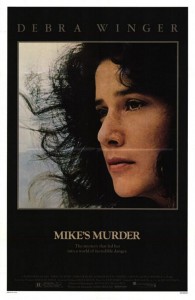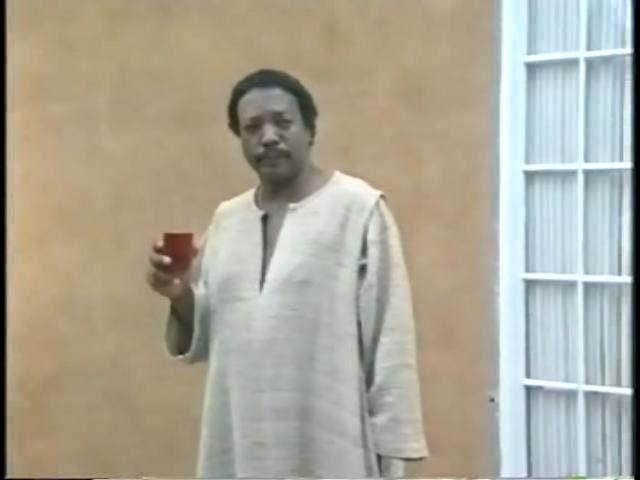“You want to know everything? Well, believe me, you don’t.”
|

Synopsis:
A bank teller (Debra Winger) investigates the murder of her lover (Mark Keyloun), a tennis coach turned petty drug dealer.
|
|
Genres, Themes, Actors, and Directors:
- Amateur Sleuths
- Debra Winger Films
- Drug Dealers
- James Bridges Films
- Murder Mystery
Review:
Writer/director James Bridges originally intended for Mike’s Murder to unfold in reverse chronological order (much like Christopher Nolan’s Memento would do to such critical acclaim 16 years later) but its nervous producers decided to recut it in a more conventional direction. Fortunately, the film “as is” remains an enjoyably edgy psychological thriller, one which effectively portrays the excitement — and potential danger — a mysterious new lover can bring to one’s life. Winger is excellent in an against-type role, making us believe that the somewhat introverted Betty would take the risks she does; we remain deeply engaged in her quest for answers to Mike’s murder, and fear for her safety. Mark Keyloun as her enigmatic lover is ultimately given too little screen time to make much of an impression (he’s killed off fairly quickly in the film, as indicated by its “spoiler” title), but the rest of the supporting cast is uniformly excellent — particularly Darrell Larson as Mike’s neurotic friend Pete, and caftan-wearing Paul Winfield as a gay music producer with (like many in the film) an enormous crush on Mike. Mike’s Murder qualifies as a genuine Sleeper — though it’s oddly not listed as such in Peary’s book.
Redeeming Qualities and Moments:
- Debra Winger as Betty

- Darrell Larson as Pete

- Paul Winfield as Phillip

- Good use of authentic L.A. locales (such as the Venice canals, pictured below)

Must See?
No, but it’s recommended.
Links:
|
One thought on “Mike’s Murder (1984)”
Ultimately a must.
I’ve seen this a few times and tended to think I might just have more personal reasons for thinking of ‘MM’ as must-see. I don’t feel that way now. This is a very strong film in its own right and deserves to be seen by a wider audience, and by ffs who esp. enjoy challenging films.
I realize that the version available is not the film Bridges intended it to be. (His life partner and co-producer Jack Larson does have a print of Bridges’ intention, tho fat chance it will ever see the light of day.) But it’s not as if this linear (rather than flashback) version is a muddled mess. (Apparently consummate pro Dede Allen was brought in to edit and save the day; admirably.) It’s perfectly coherent. In fact, seeing it again just now, I was quite taken with how tense a film it is – even in scenes which would normally seem low-key. I could not stop watching.
On the surface, the film works marvelously well as a murder mystery, plain and simple. It also has the Hitchcock-like trait of an innocent being pulled into danger. (John Barry’s lush score plays into that aspect.)
But Bridges obviously had a deeper (and, it seems, more personal) concern in this film – after all, it’s named for Mike and for what happens to him. Who has not met a guy like Mike? I have – on a number of occasions, sometimes for a period of time. Mike is the kind of character you do not often see in film, at least not the way Bridges presents him. He operates as bisexual (even tho he is technically not a real one). He has magnetic, dreamboat appeal – not only because of his fuckable looks (and note how he carries himself) but because of his athletic skill. He knows he can ride on all this – and is, no doubt, conflicted about that. He knows he’s a bit of a weasel – which is why his friendship with someone like Pete makes sense. ~and why he tells Pete he’s “not good enough” for someone like Betty.
We pretty much learn all there is to know about Mike. He’s somewhat empty. He can’t let go of the things that let him effortlessly coast in life. He doesn’t disappear from the film when he dies (we see him in a lot of photos and, significantly, in a video tape sequence). I think that could be the main point about a character like Mike: he has a kind of “aw shucks” narcissism which somehow avoids being obnoxious. You can’t dislike him and, when he’s gone, you can’t forget him.
Keyloun left the film business in 1991 to become a business professional. He probably would not have had much of a film career, but he’s perfect in this part (esp. in the video sequence). He *is* this guy. I’ve actually rarely seen Winger better than she is here. She is not just ‘the girl’ and she’s not stupid; she plays Mike at his own game. In a completely unsympathetic role, Larson captures every nuance of slime. Robert Crosson (who did a ton of tv and very little film) registers believably as the gay photographer Sam. And Winfield…(who was gay) is a revelation in his small but pivotal role. (I’ve known some guys like him, too.)
The ending is a very nice, bittersweet touch.
This is one unsung film indeed. (And I, for one, am damn curious about Bridges’ own cut.)